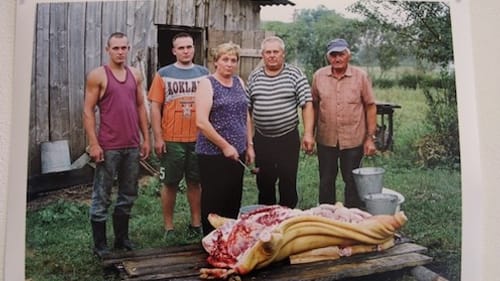Stay in the Loop
BSR publishes on a weekly schedule, with an email newsletter every Wednesday and Thursday morning. There’s no paywall, and subscribing is always free.
Lithuania in pictures
The Print Center presents Daily Life: Photography from Lithuania

Lithuanians last fall perused vintage photographs of Philadelphia. Now, it’s our turn to see images of Lithuania. An ongoing partnership between the Print Center and the Baltic nation’s cultural community has brought Daily Life: Photography from Lithuania to Latimer Street.
The compact exhibition, organized by the Lithuanian Photographers’ Association, depicts the nation’s struggle under a half century of Soviet repression and early years of independence, declared in 1990. Works from native photographers representing both periods are included.
Culture clash
It has been a transformative age, with past and present often residing in the same frame. The foreground of an Antanas Miežanskas photo from the book Redounds (1970-1975) shows a quartet of boys with Beatles bangs. Far behind them, a man stands with a cart and horse on a dirt road, as if in another century.
Almost six decades ago, Aleksandras Macijauskas traveled the countryside to record traditional life in Lithuania, where even now, arable land remains the principal natural resource. In Alytus (1970) a startling image from the book In Lithuania Rural Markets, an elderly woman stands at the back of a farm truck. She is in contemporary clothes, dark shift, checked jacket, and white shoes. On her arm she carries a large purse and on her back, a burlap sack so weighty she bends deeply and reaches out for support. Men working on the truck reach out; it’s not clear if they’re going to lift the sack away or have just settled it on her back.
The incongruities depicted by Miežanskas and Macijauskas, who are considered masters of photography, also appear in the work of recent photographers. In a color image from Mindaugas Kavaliauskas’s book Portrait of Kražai (2002), a family of five stands over the flayed carcass of a hog. One son grips a knife, his mother a ladle, and an older relative, a bucket. They stare into the camera, as though waiting for Kavaliauskas to leave so they can get on with butchering. In another image, two boys stand in tall grass, leaning on scythes. A timeless image, save for the modern logos on their clothing.

Austere symbolism, looming presence
Independence has been an ongoing struggle for Lithuania, which was the first Soviet satellite to break free. The nation first came under Russian rule in 1795, and was twice annexed by the Soviet Union, in 1940 and 1944. Since achieving independence in 1990, Lithuania joined both the European Union and NATO, developments that do not sit well with their neighbor to the southwest, which remains a looming presence.
The Soviet influence is explicit in just a few photographs — one, of troops in a chow line, from In Lithuania (1963-1986) by Romualdas Augūnas, and another from Romualdas Rakauskas’s Weekdays in Vilnius (1963-1967), of people dwarfed by stone columns, positioned like giant rolling pins about to crush them.
Reading the faces
The effect of Soviet hegemony on Lithuania can be seen throughout the exhibition. Even in post-independence photographs, expressions are solemn if not grim, a hint of hard lives shaped by unseen forces, and circumstances are modest. These people and places have struggled to survive. Yet they aspire to what we all do, as Artūras Valiauga depicts in his book I dropped in on Stepas, we talked about life (2002). He reveals an apartment papered, floor to ceiling, with glossy magazine pages showing a life far from that contained within these walls. The home is furnished simply: a table and chairs, a rumpled loveseat, and nothing requiring electricity except one ceiling light and a small radio.
A man and woman sit on the loveseat. Wearing heavy shoes and boots, bundled in sweaters, they seem to have been plucked from a rural field. They wait, unsmiling.
This couple contrasts sharply with a another photographed by Vitas Luckus for the book Relatives (1958-1986). Luckas’s subjects sit at a dining table on which are spread an array of dishes. It looks like a holiday table just before the family sits down to dinner. The frame is crowded with homey details: A plant, vase of flowers, and on the walls, religious icons, heavy drapes, and wild wallpaper. Unlike the pair on Stepas’s sofa, who seem so out of place, these two appear perfectly placed, and their expressions show it.
What, When, Where
Daily Life: Photography from Lithuania. Through April 22, 2017 at the Print Center, 1614 Latimer Street, Philadelphia. (215) 735-6090 or printcenter.org.
Sign up for our newsletter
All of the week's new articles, all in one place. Sign up for the free weekly BSR newsletters, and don't miss a conversation.